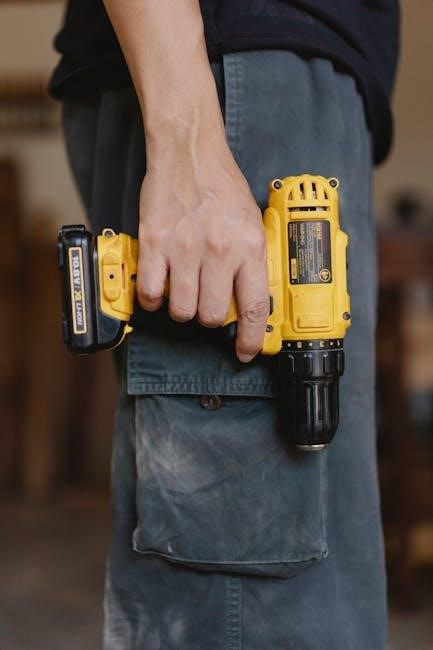Manual workers in New York play a vital role in the state’s economy, contributing to industries like construction, transportation, and manufacturing. Their labor is essential for urban development and infrastructure maintenance, ensuring the city’s dynamic operations. New York’s labor laws provide specific protections and regulations for these workers, recognizing their importance in sustaining the state’s growth and productivity.
1.1 Definition and Overview
A manual worker in New York is defined under Section 190(4) of the New York Labor Law as a mechanic, workingman, or laborer. These individuals are primarily engaged in physical or manual labor, often in roles requiring hands-on tasks. The New York Department of Labor further specifies that employees spending at least 25% of their worktime in physical labor qualify as manual workers. This classification is crucial for determining wage regulations, protections, and benefits under state labor laws.
1.2 Importance of Manual Workers in the New York Economy
Manual workers are indispensable to New York’s economy, powering key sectors like construction, manufacturing, and transportation. They build infrastructure, maintain public services, and support small businesses, driving urban development and employment. Their contributions ensure the state’s economic vitality, making them a cornerstone of New York’s workforce and growth.

Legal Definition of a Manual Worker
A manual worker is legally defined under New York Labor Law Section 190(4) as a mechanic, workingman, or laborer engaged in physical labor.
2.1 New York Labor Law Section 190(4)
Section 190(4) of the New York Labor Law explicitly defines a manual worker as a mechanic, workingman, or laborer. This legal classification encompasses individuals primarily engaged in physical labor, ensuring their work is recognized under state labor protections. The law serves as the foundation for determining employment rights, wages, and workplace conditions for manual workers in New York, aligning with the Department of Labor’s criteria for classification.
2.2 Classification as Mechanics, Workingmen, or Laborers
Under New York labor laws, manual workers are classified as mechanics, workingmen, or laborers based on their primary duties. This classification is determined by the nature of their work, with a focus on physical labor. The NYDOL criteria state that employees spending at least 25% of their time in physical labor qualify as manual workers, distinguishing them from other types of workers and ensuring specific protections and payment requirements apply to their employment.

Roles and Examples of Manual Workers
Manual workers in New York include mechanics, laborers, and workingmen engaged in construction, delivery, and manufacturing. They perform physically demanding tasks, such as building, moving goods, and handling materials.
3.1 Common Occupations Classified as Manual Labor
Common manual labor occupations in New York include construction workers, delivery personnel, manufacturing line workers, warehouse laborers, and maintenance staff. These roles involve physical tasks like lifting, moving materials, and operating machinery. Construction workers build infrastructure, while delivery personnel handle logistics. Manufacturing and warehouse workers ensure goods are produced and distributed efficiently. Maintenance staff keep facilities operational, highlighting the diverse yet physically demanding nature of manual labor roles in New York.
3.2 Industries Where Manual Workers Are Predominant
Manual workers are predominantly found in industries like construction, manufacturing, transportation, and warehousing. Construction relies on laborers for building and infrastructure projects, while manufacturing depends on workers for assembly lines and production. Transportation and logistics industries employ manual workers for delivery and distribution tasks. Additionally, agriculture and retail sectors utilize manual labor for tasks like farming and inventory management, underscoring the critical role of these workers in maintaining economic operations across diverse sectors.

Department of Labor (DOL) Criteria
The DOL defines manual workers based on their primary duties, emphasizing roles requiring physical labor. This classification ensures proper wage and labor law compliance for workers.
4.1 The 25% Physical Labor Test
The DOL’s 25% Physical Labor Test classifies employees as manual workers if they spend more than 25% of their work time engaged in physical labor. This criterion ensures accurate classification, affecting wage requirements and labor protections. It distinguishes manual labor from administrative or managerial roles, providing clarity for employers and employees alike in New York.
4.2 How the DOL Classifies Manual Workers
The New York Department of Labor classifies manual workers based on their primary duties and time spent in physical labor. Employees are considered manual workers if they meet the 25% physical labor threshold, engaging in tasks requiring manual skill or physical effort. This classification ensures they receive proper wage protections and labor rights under New York State law, distinguishing them from administrative or professional roles.

Wage and Payment Requirements
New York requires timely payments to manual workers, often weekly or bi-weekly, ensuring compliance with labor laws to protect their financial rights effectively.
5.1 Payment Frequency and Methods
Manual workers in New York are typically paid weekly, bi-weekly, or twice a month, following state labor laws. Employers must adhere to set schedules, ensuring timely compensation. Payment methods include direct deposit, checks, or payroll debit cards. These practices align with legal standards to protect workers’ financial rights effectively.
5.2 Specific Regulations for Manual Workers
New York labor laws mandate specific regulations for manual workers, ensuring they receive fair compensation and benefits. Employers must follow strict payment schedules, with options for weekly, bi-weekly, or twice-monthly pay. Additionally, the state enforces the “25% physical labor test,” requiring accurate classification of workers. Non-compliance can lead to penalties, emphasizing the importance of adhering to these regulations to protect both employees and employers.
Recent Amendments to Labor Laws
Recent amendments to New York labor laws, including Governor Hochul’s budget bill, aim to enhance protections and clarify classifications for manual workers, effective 2023.
6.1 Governor Hochul’s Budget Bill Amendment
Governor Hochul’s budget bill amendment introduced significant changes to New York’s labor laws, specifically addressing the classification and rights of manual workers. The amendment aimed to modernize existing regulations, ensuring better protections and clearer definitions for those engaged in physical labor. It particularly focused on wage requirements and classifications, aligning with the state’s efforts to enhance worker protections while maintaining economic stability.
6.2 Impact of Changes on Manual Workers
The amendments to New York’s labor laws under Governor Hochul’s budget bill have significantly impacted manual workers by clarifying their classifications and enhancing protections. The updated definitions ensure better alignment with modern work conditions, providing clearer guidelines for employers and employees alike. These changes aim to reduce wage discrepancies and improve compliance, ultimately benefiting manual workers by safeguarding their rights and improving working conditions across various industries.
Rights and Protections for Manual Workers
Under New York Labor Law, manual workers are safeguarded with specific protections ensuring timely wage payments and safe working conditions. The NYDOL enforces these rights rigorously.
7.1 Labor Law Protections in New York State
New York State provides robust protections for manual workers under its labor laws, ensuring fair wages, safe working conditions, and timely payments. Section 190(4) of the NYLL defines manual workers as mechanics, workingmen, or laborers, entitling them to specific rights. The state enforces strict regulations to prevent wage theft and ensures compliance with workplace safety standards. These protections are designed to safeguard manual workers’ rights and promote a fair work environment across all industries.
7.2 Enforcement Mechanisms by the NYDOL
The New York Department of Labor (NYDOL) enforces labor laws through investigations, audits, and penalties for non-compliance. Manual workers can file complaints with the NYDOL, triggering inquiries into wage disputes and unsafe conditions. Employers found violating labor laws face fines and legal actions. The NYDOL also provides resources to educate workers about their rights, ensuring they receive fair treatment under state regulations. These mechanisms help protect manual workers and uphold labor standards across New York.
Challenges Faced by Manual Workers
Manual workers in New York often face workplace safety hazards, wage discrepancies, and non-compliance issues. These challenges threaten their well-being and trust in employers, requiring urgent attention.
8.1 Workplace Safety and Hazard Risks
Manual workers in New York frequently encounter workplace safety hazards, particularly in construction and manufacturing. Physical labor exposes them to equipment accidents, falls, and injuries. These risks can lead to severe harm or fatalities, causing emotional and financial strain on workers and their families. Non-compliance with safety standards worsens these dangers, highlighting the need for stricter enforcement and better protective measures to safeguard manual workers’ well-being.
8.2 Wage Discrepancies and Non-Compliance Issues
Manual workers in New York often face wage discrepancies due to non-compliance with labor laws. Some employers misclassify workers or delay payments, leading to financial instability. These issues are compounded by inconsistent enforcement of payment regulations, leaving workers vulnerable to unpaid wages or incorrect paychecks. Non-compliance can result in legal action against employers, while workers may seek remedies through complaints or legal proceedings to recover owed compensation and ensure fair treatment.
Manual workers are crucial to New York’s economy, with legal protections ensuring fair treatment. Recent labor law amendments aim to enhance their rights and future opportunities.
9.1 Summary of Key Points
Manual workers in New York are defined under Section 190(4) as mechanics, workingmen, or laborers. They are vital to the economy, particularly in construction, manufacturing, and transportation. The DOL’s 25% physical labor test classifies them, ensuring specific wage and payment regulations. Recent legal amendments, like Governor Hochul’s budget bill, have expanded protections. Despite progress, challenges like workplace safety and wage discrepancies persist, highlighting the need for continued advocacy and enforcement of labor rights to support these essential workers.
9.2 Future Outlook for Manual Workers in New York
The future for manual workers in New York appears promising, with ongoing legislative support and increasing focus on workplace safety. Technological advancements may reshape job roles, requiring upskilling. Infrastructure projects and green initiatives are expected to boost demand, while unions and advocacy groups continue to push for fair wages and better working conditions. Education and training programs will be crucial to ensure manual workers remain competitive in a evolving economy.

